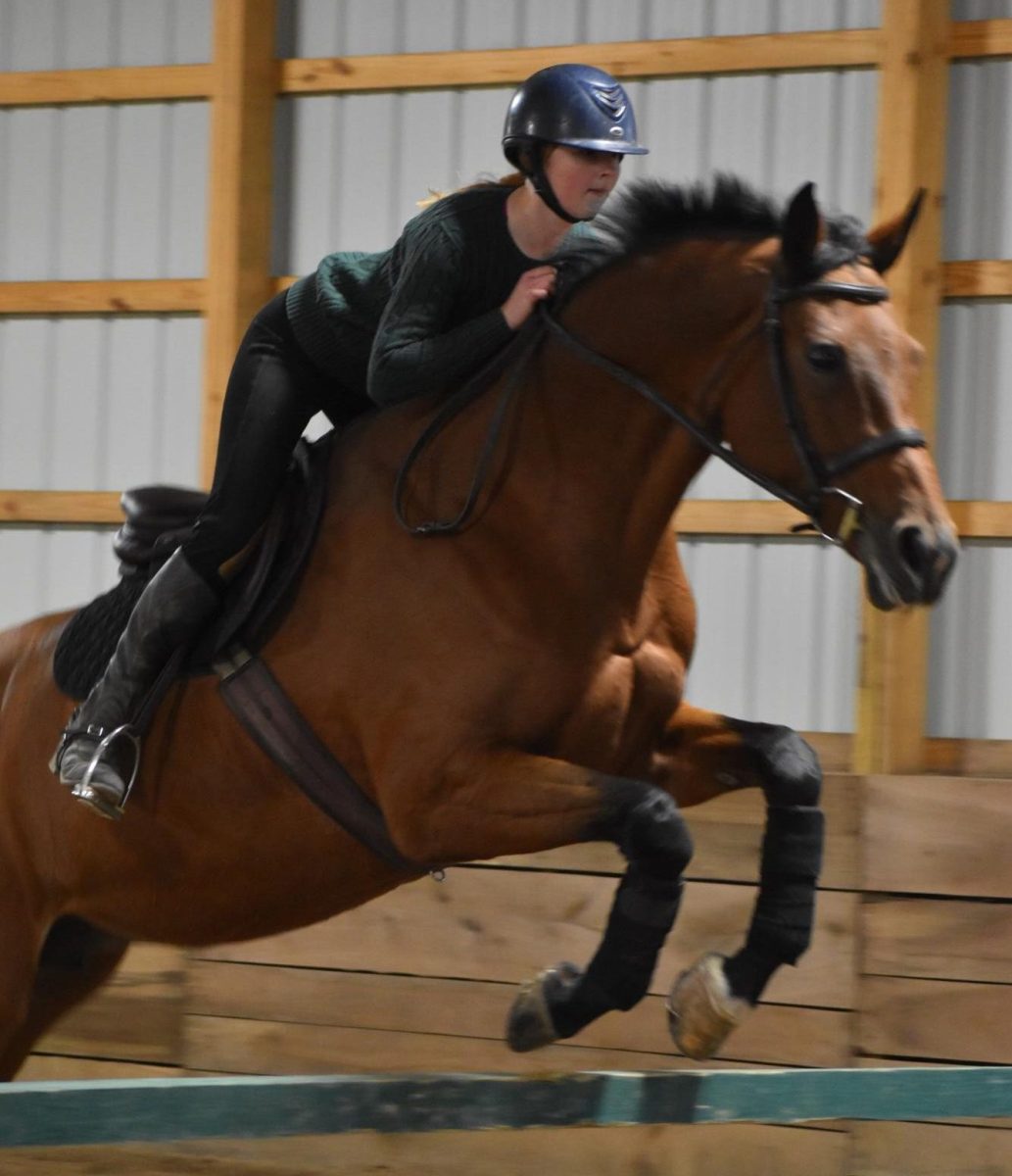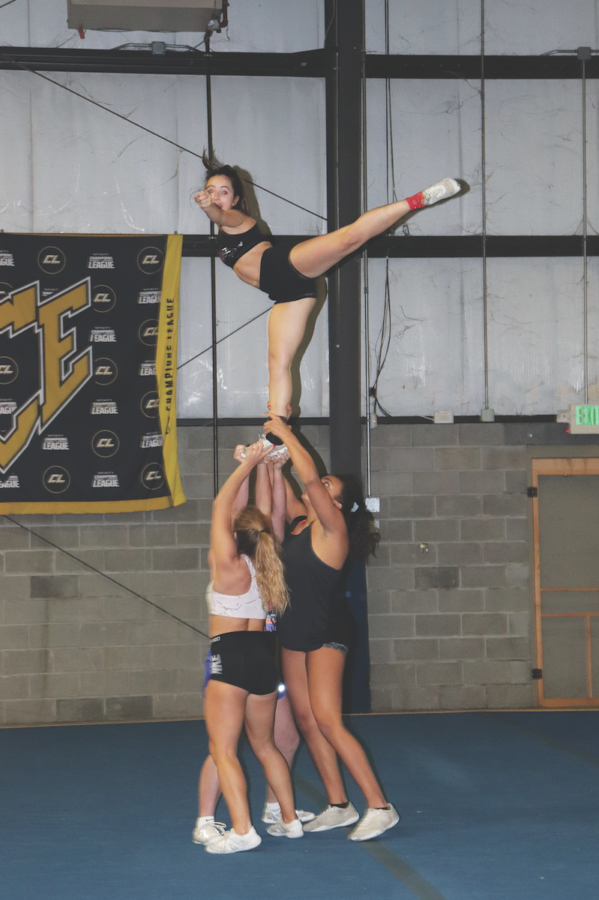After the fall season, cheerleaders usually take on one of two different paths for the winter season: Intensity Cheer Extreme (ICE), a tournament team with a gym based in Westfield, or CHS winter cheerleading. ICE and CHS winter cheerleading have similarities, which could be responsible for confusion between the two. However, there are also clear differences.
“Winter cheerleading at the high school is a lot different than a competitive cheer at a gym like ICE,” Eve Szydlowski, winter cheerleader and senior, said. “Although we do a lot of similar things, we’re sort of on opposite ends of the ‘cheer spectrum.’”
According to Szydlowski, winter cheerleading only cheers at games and does sideline cheer whereas ICE competes against other teams from different places. “(Winter cheerleaders) really just cheer at basketball games, a lot like the football cheerleaders,” Szydlowski said.
Winter cheerleading coach Nicole Vetter said the divide between winter cheer paths depends on which season are active for the cheerleaders.
“ICE is a competitive program that is strictly outside of CHS,” she said via email. “A lot of girls do this in their ‘off season’ and compete against other competitive clubs or gyms around the state and country. There is overlap from ICE, as well as other competitive gyms in the Indianapolis area, but ICE is strictly competitive cheer, not sideline cheer.”
Another aspect that differentiates the two is training intensity.
“The training definitely isn’t very rigorous since most of us have cheered for multiple seasons,” Szydlowski said. “Most of us go to tumbling once or twice a week year round, but other than that we don’t have a super intense training schedule.”

Winter cheerleaders, senior Eve Szydlowski and junior Trinity Griffin, practice their routine. Szydlowski said the time commitment for winter cheerleading is less intense compared to football cheer or ICE.
According to Taylor Ryan, ICE cheerleader and sophomore, training intensity is different for ICE. Ryan used to be a winter cheerleader and said that since her training at ICE she realized that it was more intense and rigorous at ICE.
“Our practices are three hours, and in the first hour we start with a warmup and get ready for the workout,” Ryan said. “In the second and third hours, we do something called a full-out where we do everything in two minutes and 30 seconds and then repeat it.”
According to Szydlowski and Ryan, time commitment between the two programs is also very different.
“I would definitely say the time commitment for winter cheerleading is a lot less than football competition cheer. Each week we practice two days after school and then of course cheer at the basketball games,” Szydlowski said. “When there’s a lot of games we spend a lot of time practicing and traveling, but other than that the time commitment isn’t that intense; I still find plenty of time to work and finish homework.”
However, Ryan said the time commitment is very different for ICE.
“I practice for three hours, three days a week, on Tuesdays, Thursdays, and Sundays,” Ryan said. “It is definitely a time commitment because I have to start my homework later each night since I have to drive to and from practice.”
ICE requires some physical conditioning out of its cheerleaders, according to Ryan. She said that most of her teammates regularly condition themselves through either dietary restrictions or intense physical workouts.
According to Szydlowski, practices are the only time winter cheerleaders train and condition.
“We don’t really train other than practices, and at practices we do a lot of stunting which is difficult but we really enjoy it,” Szydlowski said.
Ryan also said she believes the main difference between winter cheer and ICE is the pressure aspect of performing.
“For CHS cheer, there are only three competitions before the state competition which is the big performance,” Ryan said. “But for ICE, our work leads up to the world championship which I feel takes much more pressure than just state.”



































![British royalty are American celebrities [opinion]](https://hilite.org/wp-content/uploads/2024/03/Screenshot-2024-03-24-1.44.57-PM.png)


















![Review: “Suits” is a perfect blend of legal drama and humor [MUSE]](https://hilite.org/wp-content/uploads/2024/04/unnamed-1.png)
![Chelsea Meng on her instagram-run bracelet shop [Biz Buzz]](https://hilite.org/wp-content/uploads/2024/04/IMG_2446-1200x838.jpg)
![Review: Quiet on Set: The Dark Side of Kids TV is the long awaited exposé of pedophilia within the children’s entertainment industry [MUSE]](https://hilite.org/wp-content/uploads/2024/04/unnamed.jpg)
![Review: “The Iron Claw” cannot get enough praise [MUSE]](https://hilite.org/wp-content/uploads/2024/04/unnamed.png)
![Review: “The Bear” sets an unbelievably high bar for future comedy shows [MUSE]](https://hilite.org/wp-content/uploads/2024/03/unnamed.png)
![Review in Print: Maripaz Villar brings a delightfully unique style to the world of WEBTOON [MUSE]](https://hilite.org/wp-content/uploads/2023/12/maripazcover-1200x960.jpg)
![Review: “The Sword of Kaigen” is a masterpiece [MUSE]](https://hilite.org/wp-content/uploads/2023/11/Screenshot-2023-11-26-201051.png)
![Review: Gateron Oil Kings, great linear switches, okay price [MUSE]](https://hilite.org/wp-content/uploads/2023/11/Screenshot-2023-11-26-200553.png)
![Review: “A Haunting in Venice” is a significant improvement from other Agatha Christie adaptations [MUSE]](https://hilite.org/wp-content/uploads/2023/11/e7ee2938a6d422669771bce6d8088521.jpg)
![Review: A Thanksgiving story from elementary school, still just as interesting [MUSE]](https://hilite.org/wp-content/uploads/2023/11/Screenshot-2023-11-26-195514-987x1200.png)
![Review: When I Fly Towards You, cute, uplifting youth drama [MUSE]](https://hilite.org/wp-content/uploads/2023/09/When-I-Fly-Towards-You-Chinese-drama.png)
![Postcards from Muse: Hawaii Travel Diary [MUSE]](https://hilite.org/wp-content/uploads/2023/09/My-project-1-1200x1200.jpg)
![Review: Ladybug & Cat Noir: The Movie, departure from original show [MUSE]](https://hilite.org/wp-content/uploads/2023/09/Ladybug__Cat_Noir_-_The_Movie_poster.jpg)
![Review in Print: Hidden Love is the cute, uplifting drama everyone needs [MUSE]](https://hilite.org/wp-content/uploads/2023/09/hiddenlovecover-e1693597208225-1030x1200.png)
![Review in Print: Heartstopper is the heartwarming queer romance we all need [MUSE]](https://hilite.org/wp-content/uploads/2023/08/museheartstoppercover-1200x654.png)






















![Review: Ladybug & Cat Noir: The Movie, departure from original show [MUSE]](https://hilite.org/wp-content/uploads/2023/09/Ladybug__Cat_Noir_-_The_Movie_poster-221x300.jpg)

![Review: Next in Fashion season two survives changes, becomes a valuable pop culture artifact [MUSE]](https://hilite.org/wp-content/uploads/2023/03/Screen-Shot-2023-03-09-at-11.05.05-AM-300x214.png)
![Review: Is The Stormlight Archive worth it? [MUSE]](https://hilite.org/wp-content/uploads/2023/10/unnamed-1-184x300.png)



